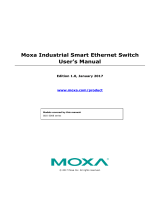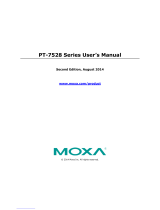
Table of Contents
1. Introduction ...................................................................................................................................... 1-1
Overview ........................................................................................................................................... 1-2
Package Checklist ............................................................................................................................... 1-2
Features ............................................................................................................................................ 1-2
Industrial Networking Capability .................................................................................................... 1-2
Designed for Industrial Applications ............................................................................................... 1-2
Useful Utility and Remote Configuration ......................................................................................... 1-2
2. Getting Started ................................................................................................................................. 2-1
RS-232 Console Configuration (115200, None, 8, 1, VT100) .................................................................... 2-2
Using Telnet to Access the ToughNet Secure Router’s Console .................................................................. 2-4
Using a Web Browser to Configure the ToughNet Secure Router ............................................................... 2-4
3. TN-5916 Series Features and Functions ............................................................................................ 3-1
System .............................................................................................................................................. 3-2
System Information ..................................................................................................................... 3-2
User Account .............................................................................................................................. 3-3
Account Password Policy .............................................................................................................. 3-4
Date and Time ............................................................................................................................ 3-5
Warning Notification .................................................................................................................... 3-8
System File Update—by Remote TFTP .......................................................................................... 3-12
System File Update—by Local Import/Export ................................................................................ 3-13
Back Up Media .......................................................................................................................... 3-13
Restart..................................................................................................................................... 3-14
Reset to Factory Default ............................................................................................................. 3-14
Port ................................................................................................................................................ 3-14
Port Settings ............................................................................................................................. 3-14
Port Status ............................................................................................................................... 3-16
Link Aggregation ....................................................................................................................... 3-16
The Port Trunking Concept ......................................................................................................... 3-16
Port Mirror ................................................................................................................................ 3-18
Using Virtual LAN .............................................................................................................................. 3-18
The VLAN Concept ..................................................................................................................... 3-18
Configuring Virtual LAN .............................................................................................................. 3-19
Multicast .......................................................................................................................................... 3-21
The Concept of Multicast Filtering ................................................................................................ 3-21
IGMP Snooping ......................................................................................................................... 3-23
IGMP Snooping Settings ............................................................................................................. 3-23
IGMP Table ............................................................................................................................... 3-24
Stream Table ............................................................................................................................ 3-25
Static Multicast MAC .................................................................................................................. 3-25
QoS ................................................................................................................................................ 3-26
QoS Classification ...................................................................................................................... 3-26
CoS Mapping ............................................................................................................................ 3-27
ToS/DSCP Mapping .................................................................................................................... 3-28
MAC Address Table ........................................................................................................................... 3-28
Interface ......................................................................................................................................... 3-29
WAN ........................................................................................................................................ 3-29
LAN ......................................................................................................................................... 3-30
DHCP .............................................................................................................................................. 3-31
DHCP Server Mode .................................................................................................................... 3-31
DHCP ....................................................................................................................................... 3-31
DHCP Leases ............................................................................................................................ 3-33
IP-MAC Binding ......................................................................................................................... 3-33
IP-Port Binding ......................................................................................................................... 3-35
SNMP .............................................................................................................................................. 3-36
DNS Server ...................................................................................................................................... 3-38
DNS Global Setting .................................................................................................................... 3-39
DNS Zone Setting ...................................................................................................................... 3-43
DNS Zone Forwarding Setting ..................................................................................................... 3-44
DNS ACL Setting ....................................................................................................................... 3-45
DNS Security Setting ................................................................................................................. 3-45
DNS Root Hints ......................................................................................................................... 3-47
Monitor ........................................................................................................................................... 3-47
Statistics .................................................................................................................................. 3-47
Bandwidth Utilization ................................................................................................................. 3-47
Packet Counter ......................................................................................................................... 3-49
Event Log ................................................................................................................................. 3-50
4. Routing ............................................................................................................................................. 4-1























